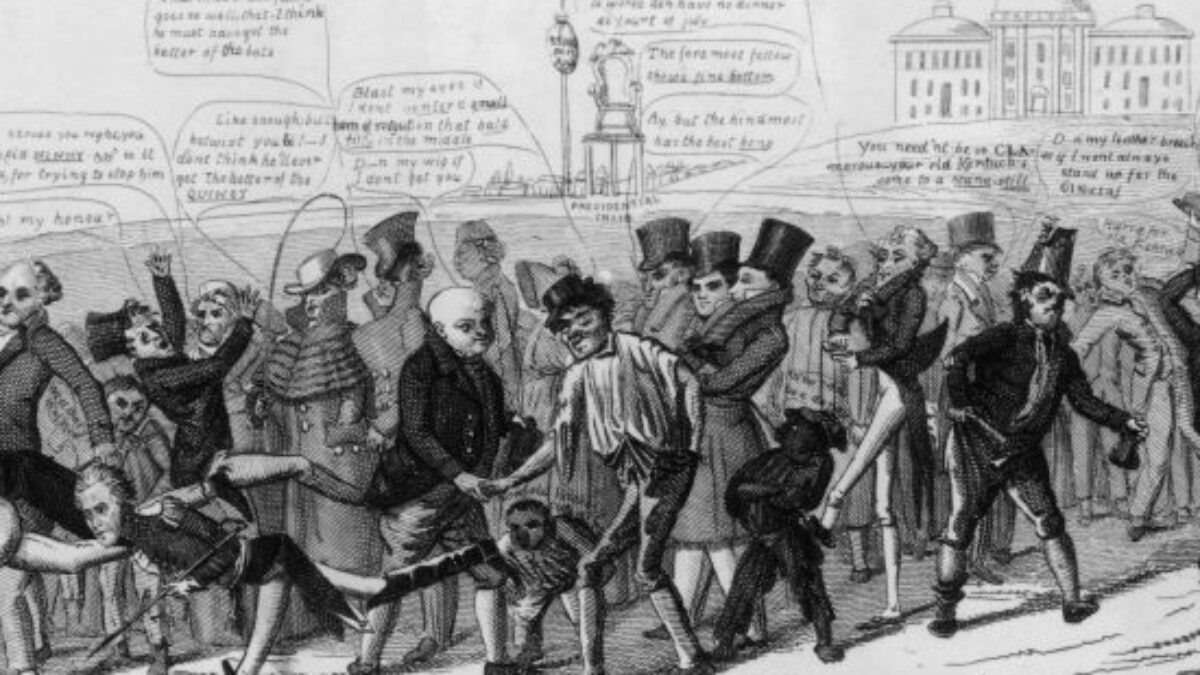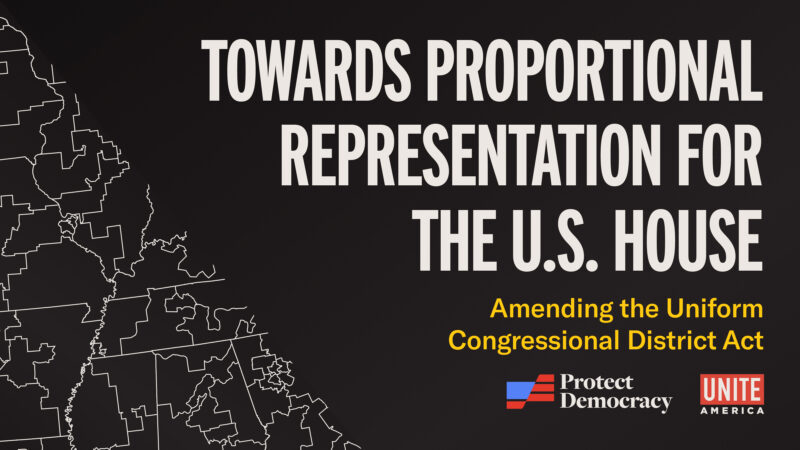Aisha Woodward leads a team at Protect Democracy focused on constraining the abuse of presidential power, restoring congressional oversight of the executive branch, and growing the pro-democracy coalition.
A contingent election, explained
- August 22, 2023
A contingent election is what happens if no candidate gets a majority in the Electoral College

To win the Electoral College, a candidate needs a majority — at least 270 electoral votes. If there are more than two candidates and no one hits 270, that triggers a contingent election, a fallback process created by the Twelfth Amendment where the House of Representatives selects a president and the Senate selects a vice president.
And there’s an additional oddity. Rather than voting individually, House members vote as state delegations. Each state delegation gets a single vote, and a candidate becomes president with the support of a majority (26) of state delegations. If no candidate wins 26 state delegations by January 20th, then the vice president-elect becomes acting president. And if the Senate fails to select a vice president, then under the Twentieth Amendment and the Presidential Succession Act of 1947, the next eligible person in the presidential line of succession (potentially the speaker of the House) becomes acting president.
I have no hesitation in saying that I have ever considered the constitutional mode of election, ultimately by the legislature voting by states, as the most dangerous blot in our constitution, and one which some unlucky chance will some day hit, and give us a pope and antipope.”
Thomas Jefferson
Since the ratification of the Twelfth Amendment, a contingent election for the presidency has only happened once, in 1825, the so-called “corrupt bargain,” when the House selected second-place finisher John Quincy Adams over Andrew Jackson (this led to broad public frustration and a populist movement that elected Jackson in a landslide four years later). Today, it’s possible that the Democratic and Republican candidates could tie with 269 electors each, but there is a more likely path to a contingent election: a third-party ticket wins a few electors and prevents anyone from getting to 270.

Want more Democracy Insights?Subscribe to our weekly newsletter
In the current climate, a contingent election could be complicated and chaotic for the health of our democracy. Unlike the normal procedure for counting votes cast by the Electoral College, which is governed by the Electoral Count Reform Act, there are no federal laws governing contingent elections. In the House, a majority of members would likely first have to adopt a special rule establishing the procedures. In the Senate, the chamber’s standing rules would govern the process, allowing for the use of the filibuster unless a majority of senators amended the rules to invoke the so-called “nuclear option.”
Unlike the counting of electoral votes, which is governed by the Electoral Count Reform Act, there are no federal laws governing contingent elections.
This lack of legal and procedural clarity leads to at least nine serious crisis risks, opportunities for abuse, or flash points that could trigger instability and chaos. As we know from recent history, these conditions present opportunities for bad actors to attempt to subvert the outcomes and stoke civil unrest—or even violence.
- Faithless electors and court challenges could consume the process and change the results: Roughly two-thirds of presidential electors are subject to “faithless elector” laws that require them to vote for their pledged candidate. Many states automatically remove and replace electors who attempt to defect. But in a scenario where Electoral College deadlock is apparent and the likely winner of a contingent election is not the candidate preferred by a majority of electors, many of them — even those from states with faithless elector laws — could attempt to change their votes anyway, leading to extensive and potentially determinative court challenges. Faithless electors may also trigger objections when Congress convenes to count electoral votes, complicating that process and potentially inviting attempts to abuse it.
- Narrow margins and high stakes in the House empower a small handful of extremist lawmakers: As with the start of the 118th Congress, a small group of ideologically extreme lawmakers could exert outsized control over the selection of the speaker of the House—and the procedures governing a contingent election—raising the risk of a protracted impasse or problematic concessions in the procedures to satisfy their demands.
- The House majority obstructs a contingent election: If a contingent election occurs when one party controls a majority of overall House seats, but the other has an advantage in terms of state delegations, the party that controls the majority of seats may be incentivized to obstruct the conduct of the contingent election through delay, rules changes, or other means, leaving the presidency vacant and triggering the line of succession. This could lead to a direct constitutional and legitimacy crisis.
- The House majority manipulates voting rules: While the Twelfth Amendment requires the House to vote by state delegation, it leaves unanswered fundamental questions: what quorum is required within each delegation to reach a decision? Are delegation results determined by a plurality, majority, or supermajority of members? What happens when a state’s delegation fails to meet the governing threshold? The party controlling a majority of House seats could adopt rules that maximize their advantage and undermine the other side.
- A Senate filibuster could lead to a vice-presidential vacancy: Because the Senate’s election would proceed under the chamber’s standing rules, 41 senators could block the selection of a vice president. This filibuster would hold, and could result in a vacant vice presidency, unless the Senate voted to invoke the so-called “nuclear option” to eliminate or suspend the filibuster.
- The House and Senate select political adversaries as president and vice president: If there is split control of Congress, the House and Senate could select political adversaries who are unwilling to work together. This situation was destabilizing both times it happened in American history, in 1796 and 1800, inspiring ratification of the Twelfth Amendment to minimize the chances of it happening again.
- The vice president elects themself: In the event of a tie vote in the Senate, it is an open and unresolved question if the vice president, acting in their capacity as president of the Senate, has the authority to cast a tie breaking vote — thereby choosing between themselves and their electoral opponent.
- A presidential candidate dies: Under the Twelfth Amendment, the House may only select as president someone who finished in the top three in the Electoral College. If one of those candidates dies after the Electoral College meets, there is currently no way to substitute an alternative choice from their party (their running mate, or otherwise). Thus, an untimely death could categorically prevent a majority of supportive House delegations from giving the presidency to the party that finished first in the Electoral College and popular vote. This is the only stage in the presidential election process lacking a method to replace a deceased candidate. (The Twentieth Amendment contemplates this scenario, authorizing Congress to pass a law to remedy this situation, but Congress has, to date, failed to act.)
- Disputes over presidential succession: If the presidency and vice presidency remain vacant on Inauguration Day, it is unclear whether the first two spots in the Presidential Succession Act, the speaker of the House and President Pro Tempore of the Senate, are constitutionally eligible to assume the role of acting president, or whether the highest ranking cabinet member of the outgoing administration, i.e., the Secretary of State, must take over. If this distinction determines which party controls the White House, this could be a high-stakes contest.
Even if a contingent election does succeed in electing a president in January 2025, two potential outcomes raise serious concerns around democratic legitimacy and stability:
First, the House voting by delegation selects a president against the will of the voters, elevating a candidate who did not win the plurality of electoral votes. (Not only is it likely that such a candidate would have lost the popular vote, but their party could have lost the House as well.)
Or…
Second, the House selects the plurality winner in the face of an angry and aggrieved minority faction primed to believe that a corrupt establishment has stolen the election from their candidate in an opaque process.
Polarization around the two major political parties is at the core of our democracy crisis, and Americans deserve more than two options in their elections. But the best way to build a multi-party democracy is through electoral reforms, like fusion voting, that safely incorporate additional parties into our political system without the risk of contingent elections.
In our closely divided nation, each presidential election is a test of our commitment to democratic principles and the rule of law. Today, our democracy is fragile.
A contingent election could damage it badly.
Related Content
It can happen here.
We can stop it.
Defeating authoritarianism is going to take all of us. Everyone and every institution has a role to play. Together, we can protect democracy.
Donate
Sign Up for Updates Sign Up for Updates
Explore Careers Explore Careers
How to Protect Democracy How to Protect Democracy




